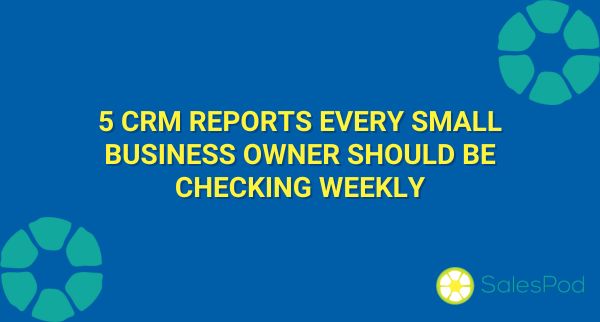Introduction
If you run a consulting business, an agency, or manage a small sales team, it’s easy to get caught up in proposals, follow-ups, and client conversations while also delivering client work and running the business. But here’s the real question: do you have a clear picture of your sales health at a glance?
For businesses where sales rely on relationships, conversations, and follow-ups (rather than self-serve online purchases), weekly CRM reporting is essential. The good news is, you don’t need to drown in data. Focusing on just five key reports gives you control, clarity, and confidence.
If most of your revenue comes from online product sales with little or no personal sales process, this post won’t apply. Hold tight for next week, when I’ll cover the key marketing-focused CRM reports that matter for you.
Why Weekly CRM Reports Matter
Sales can feel unpredictable when you’re in the trenches. A weekly reporting rhythm helps you:
- Spot problems before they snowball
- Hold yourself or your sales team accountable
- Build consistency instead of waiting for end-of-month surprises
Whether you’re a solo consultant handling every deal yourself or a business owner managing a small sales team, these reports scale to your situation.
The 5 Must-Check Weekly CRM Reports
1. Pipeline by Stage
- What it shows: Where every active opportunity stands.
- Why it matters: You’ll see if deals are moving forward or getting stuck. A stagnant pipeline usually means stalled revenue.
- Tip: For solo sellers, it’s a sanity check. For teams, it highlights coaching opportunities.
Example from Pipedrive: Deals organised by stage make it easy to spot bottlenecks and stalled opportunities.

2. New Opportunities Created
- What it shows: The number of new deals added this week.
- Why it matters: Without new deals, the pipeline eventually dries up.
- Tip: If you’re alone, this confirms whether your prospecting is consistent. With a team, it keeps reps accountable for adding opportunities.
Example from Insightly: A dashboard view showing opportunities. You would filter this to those added in the last 7 days, to check you have a steady inflow of deals.

3. Sales Activities Logged
- What it shows: Calls made, emails sent, meetings booked.
- Why it matters: Sales is a numbers game. Low activity today means revenue gaps later.
- Tip: Even as a solopreneur, tracking your effort shows whether you’re spending time on business development or just delivery.
Example from HubSpot: An activities dashboard highlights calls, emails, and meetings so you can spot dips in prospecting and sales effort.

4. Deals Won vs. Lost (and Loss Reasons)
- What it shows: Closed deals for the week, both wins and losses.
- Why it matters: This keeps focus on outcomes, not just activity. More importantly, tracking why deals are lost reveals pricing, positioning, or process gaps.
- Tip: Review losses weekly to spot trends before they become costly.
Example from CapsuleCRM: A report showing deal losses and reasons, makes it easier to learn from patterns.

5. Forecast vs. Actual Sales
- What it shows: The gap between expected revenue and actual closed revenue.
- Why it matters: Forecasting builds discipline. It forces you (or your team) to make realistic calls on deals instead of guessing.
- Tip: Use weekly checks to build a culture of accuracy and avoid end-of-month panic.
This report might come from your account system or your CRM depending on where you make financial plans and record sales values.
Making Weekly Reporting Practical
- Block 20 minutes at the same time each week
- Use dashboards so the data is one click away
- Move from data to action: ask “What does this mean, and what needs attention this week?”
This is about rhythm, not perfection. The point isn’t to become a data analyst, it’s to have the right visibility to run a sharper, more predictable sales process.
Conclusion
Whether you’re handling sales solo or managing a small team, these five CRM reports will give you the clarity you need to steer your business. They’re simple, repeatable, and powerful when reviewed consistently.

